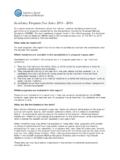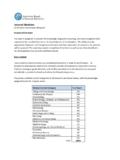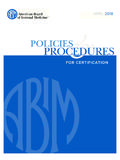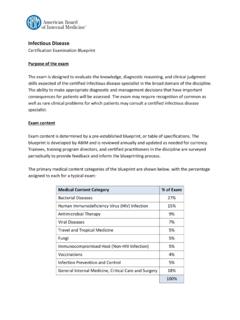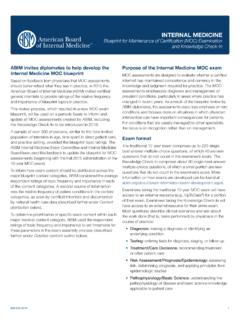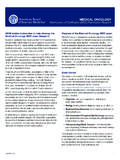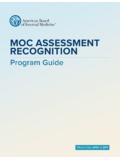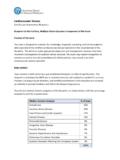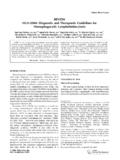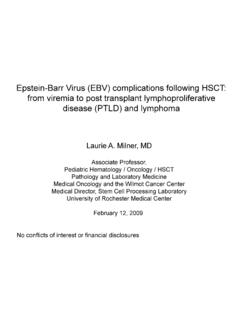Transcription of rheumatology - CERT - January 2018
1 rheumatology Certification Examination Blueprint Purpose of the exam The exam is designed to evaluate the knowledge, diagnostic reasoning, and clinical judgment skills expected of the certified rheumatologist in the broad domain of the discipline. The ability to make appropriate diagnostic and management decisions that have important consequences for patients will be assessed. The exam may require recognition of common as well as rare clinical problems for which patients may consult a certified rheumatologist. Exam content Exam content is determined by a pre established blueprint, or table of specifications.
2 The blueprint is developed by ABIM and is reviewed annually and updated as needed for currency. Trainees, training program directors, and certified practitioners in the discipline are surveyed periodically to provide feedback and inform the blueprinting process. The primary medical content categories of the blueprint are shown below, with the percentage assigned to each for a typical exam: Medical Content Category % of Exam Basic and Clinical Sciences 7% Crystal induced Arthropathies 5% Infections and Related Arthritides 6% Metabolic Bone Disease Osteoarthritis and Related Disorders 5% Rheumatoid Arthritis 13% Seronegative Spondyloarthropathies Other Rheumatic and Connective Tissue Disorders (ORCT)
3 Lupus Erythematosus 9% Nonarticular and Regional Musculoskeletal Disorders 7% Nonrheumatic Systemic Disorders 9% Vasculitides Miscellaneous Topics 2% 100% Exam questions in the content areas above may also address clinical topics in geriatrics, pediatrics, pharmacology and topics in general internal medicine that are important to the practice of rheumatology . Exam format The exam is composed of multiple choice questions with a single best answer, predominantly describing clinical scenarios. Questions ask about the work done (that is, tasks performed) by physicians in the course of practice: Making a diagnosis Ordering and interpreting results of tests Recommending treatment or other patient care Assessing risk, determining prognosis, and applying principles from epidemiologic studies Understanding the underlying pathophysiology of disease and basic science knowledge applicable to patient care Clinical information presented may include patient photographs, radiographs, micrographs, DXA scans, electrocardiograms, angiograms, and other media to illustrate relevant patient findings.
4 A tutorial including examples of ABIM exam question format can be found at The blueprint can be expanded for additional detail as shown below. Each of the medical content categories is listed there, and below each major category are the content subsections and specific topics that may appear in the exam. Please note: actual exam content may vary. Basic and Clinical Sciences 7% of Exam Anatomy, biology, and structure of musculoskeletal tissues <2% Joints and ligaments, intervertebral discs, synovium, and cartilage Connective tissue cells, matrix components, and macromolecules Bone Muscles, tendons, and bursae Blood vessels Nerves 2 Immunology Anatomy and cellular elements of the immune system Lymphoid organs: gross and microscopic anatomy and function Organization of immune system: innate and adaptive responses Specific cell types.
5 Ontogeny, structure, phenotype, function, and activation markers and cell membrane receptors Immune and inflammatory mechanisms Antigens: types, structure, processing, presentation, and elimination Components and regulation of innate immune system Major histocompatibility complex: structure, function, and nomenclature B cell receptors and immunoglobulins: structure, function, antigen binding, signaling, genetic basis, and effector function T cell receptors: structure, function, antigen binding, signaling, and genetic basis Receptor ligand interactions, adhesion molecules, complement receptors, Fc receptors, and signal transduction Complement and kinin systems.
6 Structure, function, and regulation Acute phase reactants and enzymatic defenses Cellular interactions, immune regulation, and immunomodulation Activating and inhibitory immune receptors Cellular activation, suppression, and regulation of each cell type Origin, structure, effect, site of action, metabolism, and regulation of cytokines, chemokines, and other inflammatory mediators Mechanisms of immune tolerance Immune responses IgE mediated: acute and late phase reactions Immunoglobulin mediated: opsonization, complement fixation, and antibody dependent cellular cytotoxicity Immune complex mediated: physiochemical properties and clearance of immune complexes Cell mediated: cells and effector mechanisms in cellular cytotoxicity and granuloma formation Mucosal immunity.
7 Interactions between gut and bronchus associated lymphoid tissue and secretory IgA Natural killer cells, lymphokine activated killer cells, and graft versus host reaction 3 Autoantibodies Tissue destruction and repair Cellular and molecular mediators Proteases and collagenases Research principles in basic and clinical investigation <2% Design of experimental protocols, clinical trials, and outcomes research Controls, validity, reliability, and responsiveness Outcome assessment techniques: scales, questionnaires, performance based and capacity based measurements, health status, disease activity, and functional assessment Other design of experimental protocols, clinical trials, and outcomes research Principles of epidemiology and health services research Prevalence and incidence Measurement of disease frequency Application of epidemiologic data Data analysis, biostatistics, meta analysis.
8 And medical informatics Principles of quality assessment and improvement Ethical and legal issues Bioethics of basic research and clinical trials Patient rights and confidentiality Laboratory and research techniques Serologic: enzyme linked immunosorbent assay (ELISA), radioimmunoassay (RIA), radial immunodiffusion (RID), nephelometry, immunoblots, protein electrophoresis, and circulating immune complex assays Cellular: lymphocyte proliferation, flow cytometry Histochemistry and immunofluorescence of biopsied tissues Molecular: Northern, Southern, and Western blotting, polymerase chain reaction, genetic mapping techniques, gene sequencing, and gene expression analysis Monoclonal antibody production Transgenic and gene knockout animals Principles of genetic and proteomic analysis: genetic epidemiology, gene transcription, and protein expression analysis 4 Clinical analysis <2% Synovial fluid analysis Appropriate use and interpretation of serologic, chemical, biochemical, and microbiologic laboratory tests Diagnostic imaging techniques Plain radiographs.
9 In the assessment of normal and diseased joints, bones, and periarticular structures and prosthetic joints Computed tomography, magnetic resonance imaging, radionuclide scanning, bone densitometry, and arteriography: principles of imaging of joints, bones, and periarticular structures and tissues Ultrasonography: principles of imaging of joints and periarticular structures and tissues Electromyograms and nerve conduction studies: indications for and interpretation of results Biopsy and pathology: diagnostic interpretation of pathologic specimens of specific tissues Pharmacology: dosing, pharmacokinetics, metabolism, mechanisms of action, adverse effects, and drug interactions Nonsteroidal anti inflammatory drugs Glucocorticoids.
10 Topical, intra articular, and systemic Systemic antirheumatic drugs Disease modifying antirheumatic drugs (DMARDs) and immunosuppressive, cytotoxic, and immunomodulatory drugs Biologics Urate lowering therapy Antiresorptive bone agents Anabolic bone agents Antibiotic therapy for septic joints Opioid and nonopioid analgesics Colchicine Plasma exchange Vaccines Intravenous immunoglobulin (IVIG) 5 Crystal induced Arthropathies 5% of Exam Gout Primary gout Asymptomatic hyperuricemia Acute gout Intercritical periods Tophaceous gout Conditions associated with gout Lead intoxication Secondary gout Lesch Nyhan syndrome Other secondary types of gout Calcium pyrophosphate dihydrate deposition (CPPD) <2% Familial Secondary to primary metabolic disorders Idiopathic CPPD Basic calcium phosphate crystal deposition <2% Infections and Related Arthritides 6% of Exam Infections 5% Bacterial (nongonococcal and gonococcal)
